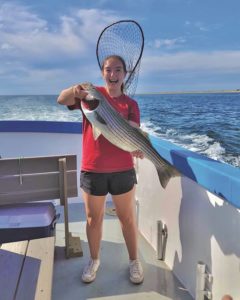Striped bass fishing was excellent this past week, falling steadily into our expected summer pattern. The fish have been spreading out along the bay side from Race Point to Wood End, and the Race Station on the backside yielded some big fish, as did Head of the Meadow.
The fish have gotten bigger. We are seeing a better than 50-percent ratio of keepers to nonkeepers lately, and that is a significant improvement over two weeks ago. Bluefish have arrived, though not in big numbers. We caught our first bluefish on the exact same date this year as we did last year. There is a lot to be said for consistency — and for keeping a log to help you recognize the patterns.

Now that the summer season is in gear, it’s time to mention the mess that occurs when trolling boats, drifting boats, and anchored boats are all vying for the same fish in the same area. Many boaters seem to be unaware of what’s not OK to do out there. Much of it is just common sense. Here are a few dos and don’ts.
Don’t stop directly in front of a trolling boat. Don’t cut behind a trolling boat close to the stern. Trolling boats need to give boats with casters a wide berth. If you are casting or bait fishing, don’t throw your anchor out in the middle of a fleet of boats that are drifting. Finally, don’t go roaring at high speed into an area where boats are actively fishing, and don’t depart from such areas at high speed either.
Just last Sunday, a kayaker threw his anchor very close to me — right in front of the direction in which I was drifting. Then his anchor got stuck, so he couldn’t pull it to get out of my way, and as I was hard reversing to avoid hitting him, a half dozen of my customers’ jigs got caught in his anchor line. One jig ended up hooking the kayaker in his hand. All this drama could have been avoided with just a little knowledge and common sense.
This past winter, the state’s Div. of Marine Fisheries wrote new rules and recommendations for aquaculture sites. Among them is Item #11, which says, “Due to the threat of food source contamination, pets/animals are not authorized on aquaculture licensed sites. Should growers on intertidal licensed sites witness or get a secondary witness account of product contamination with feces or urine from a land-based animal, the adulterated product must be segregated on the licensed site and resubmerged for ten days prior to harvest for human consumption.”
It is absolutely mind-blowing to me how many people walk their dogs on our West End shellfish flats at dead low tide and allow them to relieve themselves in and around the shellfishing areas where food is being grown for human consumption. At least the state has recognized this as an issue of concern and has written a policy about it. Now we just need signs posted around our aquaculture sites alerting the public to this policy. I wonder if this may be something for the select board to address as well.



